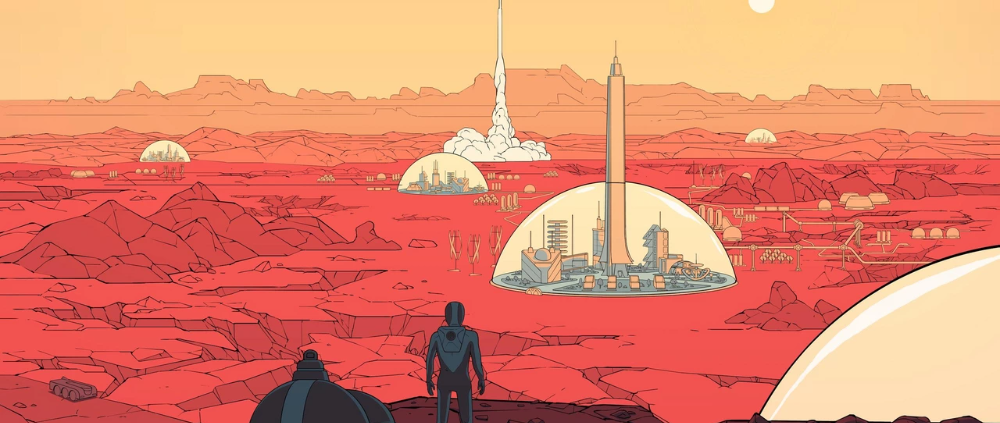The New Colonists
The New Colonists
March 23. 2030.
As I blew out the candles during my final birthday on earth, I silently wished that it wasn’t true. We had heard my number on the vintage television, nearly a month ago. On the first day of the third wave draft, my number was announced. I was to be the final wave of new colonists. I glanced out my window to see ash coating the ground. It was nearly an inch thicker than last year, a trend that had continued for nearly a decade.
As the last remnants of happy birthday were swallowed up by silence, I finally spotted him. I had been glancing out the window nearly every sixty seconds, praying that they had forgotten about me. Praying that my house radiated an aura of warmth, a scorching, hot embrace so powerful that it was impossible to pry me from its wooden walls. I had no such luck.
The military man’s unintimidating waddle would have been hilarious to a younger me, but how could I laugh when I knew the reason for his visit. He beckoned at me from just outside. I hugged my parents tightly, certain that this was the last birthday we would spend together. “I’ll see you soon” I whispered to them, a sentiment that none of us believed, and met the officer as I stepped outside into the ash.
Ten thousand citizens were chosen to embark on this third pilgrimage to Mars. The first wave had been scientists who were charged with establishing oxygen, water and terraforming the planet. The second wave was labor and power; those who provided service or capital to the creation of the new colony. This third wave consisted of an unwilling civilian corp.
The trek was estimated at seven months, one way. In the beginning, governments took only volunteers. But interest plummeted when it was revealed that only one member per family could be sent. Human revolt coincided with continued environmental destruction. To quell the growing distress, the government instituted a global draft. That is how I found myself on an overcrowded spaceship, a hundred million miles away from home, completely alone.
Almost seven months to the day from my last moments on earth, I looked out the starboard window and was shocked to see us hurtling towards a planet. It was so strange; this was a Mars unlike anything I had ever imagined. It was half as big as I expected and severely misshapen. It looked like an aluminum can that was just crushed by a child learning its own strength. The sight got more shocking as we got closer.
It seemed briefly that humanity’s plan to terraform Mars had been a success, at least in part. Half of the dust-colored planet had been replaced by vibrant hues of green and blue. As we descended, I could see the relief on everyone’s face. Those blues and greens, at least from the perspective of an outsider looking in, seemed like a comforting invitation to safety, a familiar attempt to recreate the world we can no longer return to.
The collective sighs of relief were cut short by our next discovery of the trip: there were three gaping chasms, three humongous holes that bore their way to the center of Mars. They seemed completely out of place. They looked both familiar and unnatural, too large to be man-made. And yet, there was no scientific record of this phenomenon.
“It looks like a bowling ball,” said a younger child who sat alone a few feet away. It was a whimsical, yet accurate observation. Words collected on thousands of lips, but the silence continued as the new colonists assessed the three puncture wounds and the half earth-like Mars. And in a collective acceptance of circumstances beyond their control, the holes were forgotten.
The ground appeared dense. Packed together like wet sand, but with a strange absence of moisture. The half of Mars that was not terraformed looked like a shell of a once-powerful creature. It was cracking off and looked far more discolored than expected. This was to be our new home. We had been certain of this inevitability since mother earth rejected us, yet the compositional changes, the deep holes at the center, the tightly and mercilessly packed ground, and the size, were all uncanny. “Why did it feel so wrong?” I asked myself as we disembarked.
March 23. 2050.
Nearly twenty years after the third wave of humanity’s dismount, I received an answer to my questions. It was to be the last answer that humanity ever received. It came at dawn. I say it for lack of a better word; A god, or a demon, or possibly a celestial child who wandered towards the new colonists and thought of us as a collection of ants.
His features were barely recognizable to the human eye. He seemed weightless as if a cloud approached Mars and ushered in humanity’s end. As the form lurched closer to the surface of Mars, the last thing I saw began to take shape. The transformation from an amorphous blob to a hand was so rapid that I wondered if it was my mind attempting to make sense of what I was seeing.
As this force of nature reached out, he placed his three fingers into the suspicious crater holes of Mars. The only thing the new colonists could do was scream and pray. The hand did not seem angry, nor was it sinister. It was a neutral force larger than humanity.
As the new colonists begin to panic, I am transported back to earth. In my vision, I am nine again, accompanied to the bowling alley with my entire family. I struggle with the weight of the ball. Nearly all of my tosses end in the gutter. I begin laughing at the absurdity. On the precipice of humanity’s end, I am having a daydream about bowling.
I am violently whipped back to reality, as the cataclysmic force throws the entirety of Mars through space. The last thing I hear is laughter, a child laughing because he finally bowled a strike.




Leave a Reply
Want to join the discussion?Feel free to contribute!